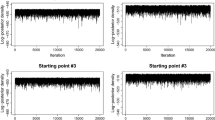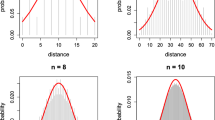Abstract
The elicitation of an ordinal judgment on multiple alternatives is often required in many psychological and behavioral experiments to investigate preference/choice orientation of a specific population. The Plackett–Luce model is one of the most popular and frequently applied parametric distributions to analyze rankings of a finite set of items. The present work introduces a Bayesian finite mixture of Plackett–Luce models to account for unobserved sample heterogeneity of partially ranked data. We describe an efficient way to incorporate the latent group structure in the data augmentation approach and the derivation of existing maximum likelihood procedures as special instances of the proposed Bayesian method. Inference can be conducted with the combination of the Expectation-Maximization algorithm for maximum a posteriori estimation and the Gibbs sampling iterative procedure. We additionally investigate several Bayesian criteria for selecting the optimal mixture configuration and describe diagnostic tools for assessing the fitness of ranking distributions conditionally and unconditionally on the number of ranked items. The utility of the novel Bayesian parametric Plackett–Luce mixture for characterizing sample heterogeneity is illustrated with several applications to simulated and real preference ranked data. We compare our method with the frequentist approach and a Bayesian nonparametric mixture model both assuming the Plackett–Luce model as a mixture component. Our analysis on real datasets reveals the importance of an accurate diagnostic check for an appropriate in-depth understanding of the heterogenous nature of the partial ranking data.



Similar content being viewed by others
References
Alvo, M., & Yu, P. L. (2014). Statistical methods for ranking data. Berlin: Springer.
Ando, T. (2007). Bayesian predictive information criterion for the evaluation of hierarchical Bayesian and empirical Bayes models. Biometrika, 94(2), 443–458.
Bulteel, K., Wilderjans, T. F., Tuerlinckx, F., & Ceulemans, E. (2013). CHull as an alternative to AIC and BIC in the context of mixtures of factor analyzers. Behavior Research Methods, 45(3), 782–791.
Caron, F., & Doucet, A. (2012). Efficient Bayesian inference for generalized Bradley–Terry models. Journal of Computational and Graphical Statistics, 21(1), 174–196.
Caron, F., Teh, Y. W., & Murphy, T. B. (2012). Bayesian nonparametric Plackett-Luce models for the analysis of clustered ranked data. Technical Report 8143, Project-Team ALEA.
Caron, F., Teh, Y. W., & Murphy, T. B. (2014). Bayesian nonparametric Plackett-Luce models for the analysis of preferences for college degree programmes. The Annals of Applied Statistics, 8(2), 1145–1181.
Celeux, G., Hurn, M., & Robert, C. P. (2000). Computational and inferential difficulties with mixture posterior distributions. Journal of the American Statistical Association, 95(451), 957–970.
Celeux, G., & Soromenho, G. (1996). An entropy criterion for assessing the number of clusters in a mixture model. Journal of Classification, 13(2), 195–212.
Dabic, M., & Hatzinger, R. (2009). Zielgruppenadaequate Ablaeufe in Konfigurationssystemen - Eine empirische Studie im Automobilmarkt - Partial Rankings. In R. Hatzinger, R. Dittrich, & T. Salzberger (Eds.), Praeferenzanalyse mit R: Anwendungen aus Marketing, Behavioural Finance und Human Resource Management. Wien: Facultas.
Dahl, D. B. (2006). Model-based clustering for expression data via a Dirichlet process mixture model. In K.-A. Do, P. Müller, & M. Vannucci (Eds.), Bayesian inference for gene expression and proteomics (pp. 201–218). New York: Springer.
Diaconis, P. W. (1987). Spectral analysis for ranked data. Technical Report 282, Department of Statistics, Stanford University, Stanford.
Gelman, A., Carlin, J. B., Stern, H. S., & Rubin, D. B. (2004). Bayesian data analysis (2nd ed.). Boca Raton: Chapman & Hall/CRC.
Gelman, A., Hwang, J., & Vehtari, A. (2014). Understanding predictive information criteria for Bayesian models. Statistics and Computing, 24(6), 997–1016.
Gelman, A., Meng, X.-L., & Stern, H. (1996). Posterior predictive assessment of model fitness via realized discrepancies. Statistica Sinica, 6(4), 733–760.
Gormley, I. C., & Murphy, T. B. (2006). Analysis of Irish third-level college applications data. Journal of the Royal Statistical Society: Series A, 169(2), 361–379.
Gormley, I. C., & Murphy, T. B. (2008). A mixture of experts model for rank data with applications in election studies. Annals of Applied Statistics, 2(4), 1452–1477.
Gormley, I. C., & Murphy, T. B. (2009). A grade of membership model for rank data. Bayesian Analysis, 4(2), 265–295.
Gormley, I. C. & Murphy, T. B. (2010). Clustering ranked preference data using sociodemographic covariates. In Hess, S., Daly, A., (Eds.), Choice modelling: The state-of-the-art and the state-of-practice. Proceedings from the Inaugural International Choice Modelling Conference (pp. 543–569). Emerald.
Guiver, J., & Snelson, E. (2009). Bayesian inference for Plackett-Luce ranking models. In Bottou, L., & Littman, M., (Eds.), Proceedings of the 26th International Conference on Machine Learning—ICML 2009 (pp. 377–384). Omnipress.
Hatzinger, R., & Dittrich, R. (2012). prefmod: An R package for modeling preferences based on paired comparisons, rankings, or ratings. Journal of Statistical Software, 48(10), 1–31.
Hunter, D. R. (2004). MM algorithms for generalized Bradley–Terry models. Annals of Statistics, 32(1), 384–406.
Jacques, J., & Biernacki, C. (2014). Model-based clustering for multivariate partial ranking data. Journal of Statistical Planning and Inference, 149, 201–217.
Luce, R. D. (1959). Individual choice behavior: A theoretical analysis. New York: Wiley.
Lukočienė, O., & Vermunt, J. K. (2009). Determining the number of components in mixture models for hierarchical data. Advances in data analysis, data handling and business intelligence (pp. 241–249). Berlin: Springer.
Marden, J. I. (1995). Analyzing and modeling rank data (Vol. 64). Monographs on Statistics and Applied Probability, Boca Raton: Chapman & Hall.
Marin, J.-M., Mengersen, K., & Robert, C. P. (2005). Bayesian modelling and inference on mixtures of distributions. Handbook of Statistics, 25, 459–507.
McCullagh, P., Yang, J., et al. (2008). How many clusters? Bayesian Analysis, 3(1), 101–120.
Miller, J. W., & Harrison, M. T. (2013). A simple example of Dirichlet process mixture inconsistency for the number of components. In Neural Information Processing Systems - NIPS, 2013, 199–206.
Miller, J. W., & Harrison, M. T. (2014). Inconsistency of Pitman–Yor process mixtures for the number of components. The Journal of Machine Learning Research, 15(1), 3333–3370.
Mollica, C., & Tardella, L. (2014). Epitope profiling via mixture modeling of ranked data. Statistics in Medicine, 33(21), 3738–3758.
Papastamoulis, P. (2016). label. switching: An R package for dealing with the label switching problem in MCMC outputs. Journal of Statistical Software, 69(1), 1–24.
Plackett, R. L. (1975). The analysis of permutations. Journal of the Royal Statistical Society: Series C (Applied Statistics), 24(2), 193–202.
Raftery, A. E., Satagopan, Jaya, M., Newton, M. A., & Krivitsky, P. N. (2007). Bayesian statistics 8. In Bernardo, J., Bayarri, M., Berger, J., Dawid, A., Heckerman, D., Smith, A., West, M., (Eds.), Proceedings of the eighth Valencia International Meeting, June 2-6, 2006, pages 371–416. Oxford: Oxford University Press.
Spiegelhalter, D. J., Best, N. G., Carlin, B. P., & Van Der Linde, A. (2002). Bayesian measures of model complexity and fit. Journal of the Royal Statistical Society: Series B (Statistical Methodology), 64(4), 583–639.
Stern, H. (1993). Probability models on rankings and the electoral process. Probability models and statistical analyses for ranking data (Vol. 80, pp. 173–195)., Lecture Notes in Statistics New York: Springer.
Yao, G., & Böckenholt, U. (1999). Bayesian estimation of Thurstonian ranking models based on the Gibbs sampler. British Journal of Mathematical and Statistical Psychology, 52(1), 79–92.
Yellott, John I. (1977). The relationship between Luce’s choice axiom, Thurstone’s theory of comparative judgment, and the double exponential distribution. J. Mathematical Psychology, 15(2), 109–144.
Author information
Authors and Affiliations
Corresponding author
Electronic supplementary material
Below is the link to the electronic supplementary material.
Rights and permissions
About this article
Cite this article
Mollica, C., Tardella, L. Bayesian Plackett–Luce Mixture Models for Partially Ranked Data. Psychometrika 82, 442–458 (2017). https://doi.org/10.1007/s11336-016-9530-0
Received:
Revised:
Published:
Issue Date:
DOI: https://doi.org/10.1007/s11336-016-9530-0




